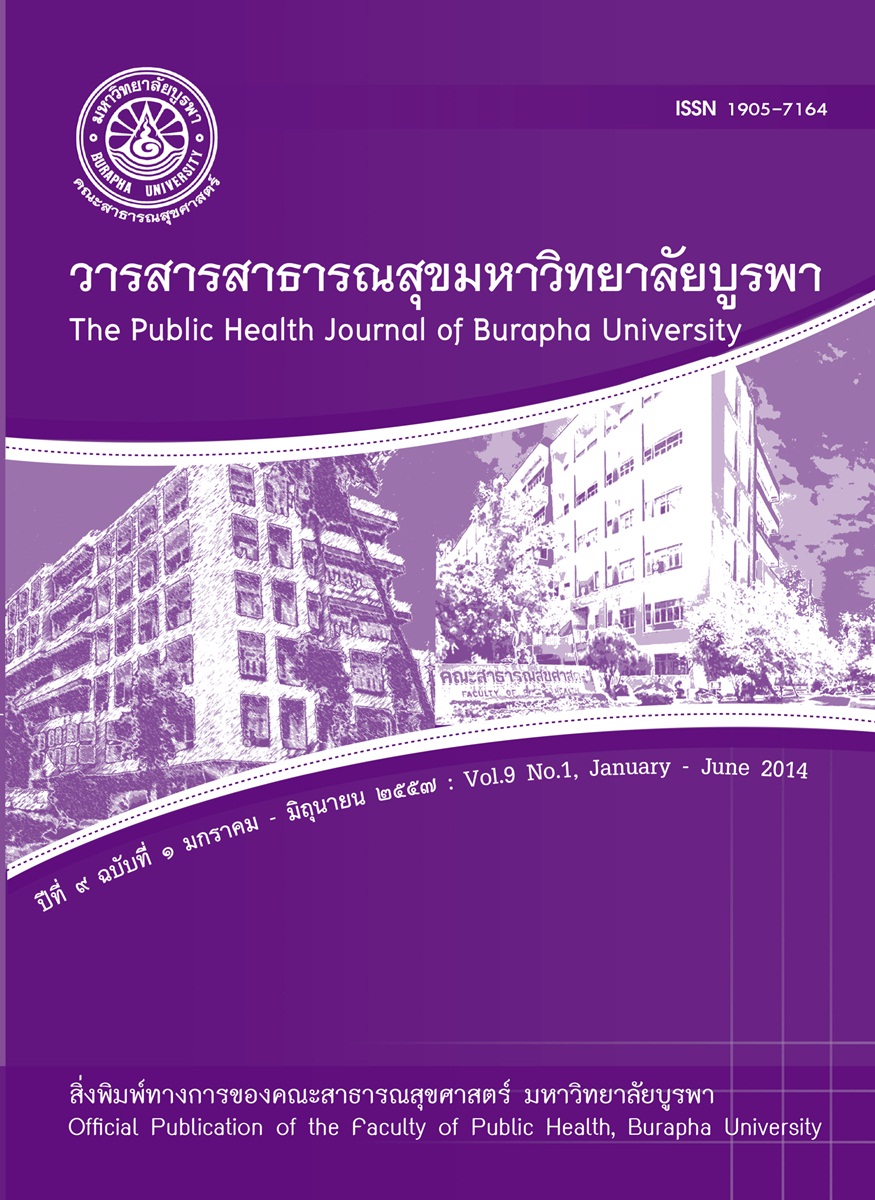พฤติกรรมการใช้ยาของอาสาสมัครประจำหมู่บ้าน ตำบลบ่อกวางทอง อำเภอบ่อทอง จังหวัดชลบุรี
Main Article Content
บทคัดย่อ
การวิจัยนี้มีวัตถุประสงค์เพื่อศึกษาพฤติกรรมการใช้ยาของอาสาสมัครประจำหมู่บ้านตำบลบ่อกวางทอง อำเภอบ่อทอง จังหวัดชลบุรี คัดเลือกกลุ่มผู้ให้ข้อมูลโดยใช้หลักการคัดเลือกตัวอย่างเชิงทฤษฎี จำนวน 42 ราย เก็บข้อมูลโดยการสัมภาษณ์เชิงลึก การสังเกต การบันทึกเสียง และการบันทึกภาคสนาม วิเคราะห์ข้อมูลโดยการวิเคราะห์ข้อมูลเชิงเนื้อหา
ผลการวิจัยนี้พบว่าอาสาสมัครประจำหมู่บ้านส่วนใหญ่มีโรคประจำตัว คือ โรคเบาหวาน และโรคความดันโลหิตสูง เลือกการรักษาแบบแผนปัจจุบัน และภูมิปัญญาท้องถิ่นควบคู่กัน บางรายเลือกรักษาแบบแผนปัจจุบันก่อนการตัดสินใจใช้วิธีอื่น เหตุผลหลักๆ เช่น อยากรู้อยากเห็นอยากลอง เพื่อนแนะนำ ใช้ตามบทความ หนังสือพิมพ์ วารสาร นิตยสาร โฆษณาต่างๆ และการประชุมประจำเดือนของอาสาสมัครประจำหมู่บ้าน หลังจากได้รับการรักษาจะมีอาการที่ดีขึ้น ถ้าไม่ดีขึ้นก็จะเปลี่ยนสถานที่หรือเปลี่ยนตัวยาหรือสมุนไพรที่ใช้รักษา แต่จะไม่เข้าใจในเรื่องผลข้างเคียง การแพ้ยา อาการไม่พึงประสงค์จากการใช้ยา ปัญหาส่วนใหญ่คือมีการใช้ยาโดยไม่ได้ตระหนักถึงอันตราย ขาดความรู้ ขาดความเข้าใจในอันตรายที่จะเกิดขึ้นจากความเชื่อผิดๆ
โดยสรุป หน่วยงานราชการส่วนท้องถิ่นสามารถปรับใช้เพื่อพัฒนางานเยี่ยมบ้านในเชิงรุก เพื่อดูการใช้ยา ยาเหลือค้าง เพื่อช่วยเหลือ และลดความคาดเคลื่อนทางยา เช่น ได้รับยาซ้ำซ้อน การเกิดอันตรกิริยาระหว่างยา และควรศึกษาพฤติกรรมการใช้ยาสมุนไพรร่วมกับยาแผนปัจจุบัน และสำหรับเจ้าหน้าที่สาธารณสุขสามารถนำข้อมูลไปพัฒนาพฤติกรรมการใช้ยาในท้องถิ่นของตน
DRUG USE BEHAVIOR OF VILLAGE HEALTH VOLUNTEER AT BO KWANGTHONG SUB-DISTRICT, BO THONG DISTRICT, CHONBURI PROVINCE
The purpose of this research was to study drug use behavior of village health volunteer at Bo Kwangthong sub-district, Bo thong District, Chonburi province. The key informant was 42 subjects selected by theoretical sampling. In-depth interview, observation, voice recording and note taking were used to collect data. Content analysis was employed to analyze the data.
The results of this study showed that diabetes and hypertension were mostly found in subjects. Both conventional medicine and traditional medicine were taken. Some chose conventional medicine first before taking other ways due to curiosity, suggestions, information from articles, newspapers, journals, magazines, advertisements, and village health volunteer’s monthly meeting. After the treatment if their symptoms did not improve, they changed and took other medicine or herb. They did not understand about side-effect, drug allergy and adverse drug reactions. Most of the village health volunteers did not realize how dangerous the drugs was due to lack of knowledge, lack of understanding about the fourth-coming threats caused by drug using and also had false beliefs.
The results of this study can be used to develop proactive home visit programs to check drug used and drug storage. This could help decrease medical error such as drug redundant using and drug interaction. Further study is needed in regards to herbal and conventional co-treatment. Public health personals can use the results to improve drug use behavior in their communities.

